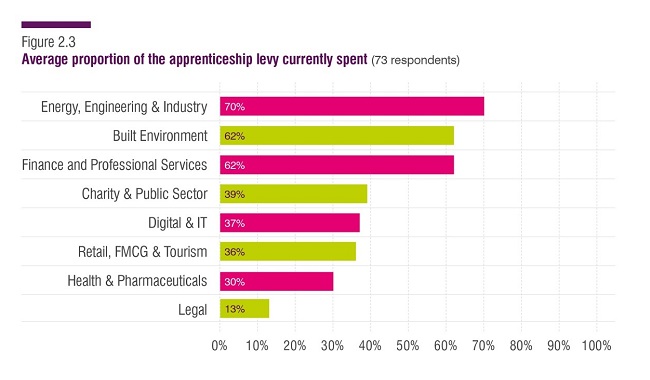ISE’s Student Development report shows how employers are moving towards school leavers to tackle skills shortages, explains researcher Nicola Thomas.
In ISE’s Student Development Report 2022 we noted an increasing shift away from graduate hiring and towards school and college leavers as companies seek to diversify their hiring practices in the face of a skills shortage.
That is not to say that organisations are foregoing graduate recruitment, but rather employers are increasingly tapping into more diverse hiring channels to strategically meet the needs of the business.
This is evident when we look at the percentage of the apprenticeship levy spent and the projected number of vacancies for school leavers.
Significant increase in use of apprenticeship levy
The apprenticeship levy is a core part of many organisations’ development budget. Employers are now hiring more apprenticeships and are making better use of the levy system.
This year survey respondents reported that they were spending on average 47% of the apprenticeship levy. This is the highest average spending we have reported and a significant increase on a few years ago when the average employer only recovered a fifth of their levy tax.
In 2021 employers were spending 32% of their levy pot, 39% in 2020 and 33% in 2019. This suggests the use of the levy has increased since the initial stagnation through the pandemic.
Yet, there are two things to bear in mind. One is that many employers still find the levy system inflexible and welcome Rishi Sunak’s announcement of a review due to take place this autumn. The second is that there is significant deviation of levy spend across sectors.
Namely, the energy, engineering and industry sector made use of 70% of the apprenticeship levy. This is compared with the legal sector that only spent 13% of the levy.

Strong commitment to school leaver recruitment
When we look at the recruitment growth and forecast from 2018 to 2022 we can see that throughout the pandemic vacancies fell for graduates, interns and placement students, but continued to rise steadily for school and college leavers (ISE Student Recruitment Surveys such as 2020).
This highlights continued growth as employers strategically align their hiring practices with school leavers to build a strong talent pipeline in the face of major talent acquisition challenges.

This shift to school and college leavers makes a lot of sense considering that after five years of employment, 64% of school and college leavers are retained. This is compared with only 53% of graduates (Read blog on latest rentention rates for more information).
When considering the level of investment organisations make in their apprentices and graduates through development programmes, retention becomes a core commercial aim as employers are keen to both retain the talent they have invested in, and to continue to see their early-career hires flourish in their organisation.
School leavers’ skills flourish
The shift towards school and college leavers has also been driven by the need for more specific skills that can be trained on the job, rather than the ‘generic’ skills focused on in a university context.
The investment in school and college leavers is reaping benefits with employers reporting not only a reduction in turnover compared to graduates but also an increase in the skills school and college leavers possess. Namely, in 2022 the top areas of skill growth for school and college leavers were self-motivation (up 9% from 2021), adaptability (up 8%), positive thinking (up 8%), resilience (up 6%) and self-awareness (up 4%).
Read more information on the Covid effect on graduate and school leaver skills
By shifting focus to school and college leavers employers are committing to building a more diverse cohort of early career hires – tapping into talent that they otherwise would not access. This enables organisations to ease some of the recruitment difficulties down the line as they can fill gaps internally through their pipeline instead of seeking to appoint from external candidates.
Download ISE’s Student Development Report 2022
Catch up with ISE’s latest event on student development


0 Comments